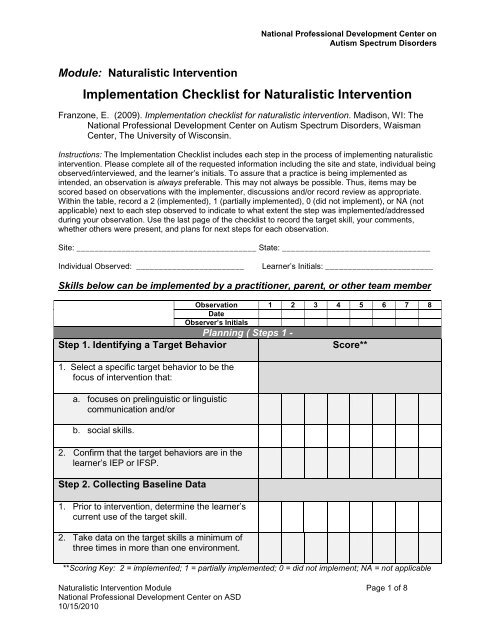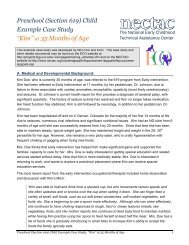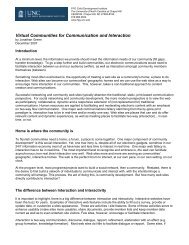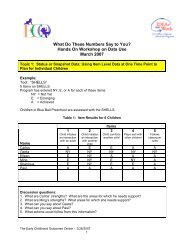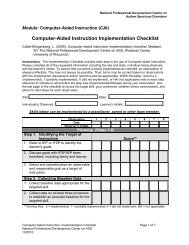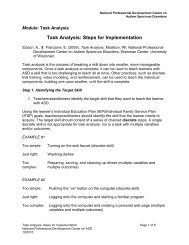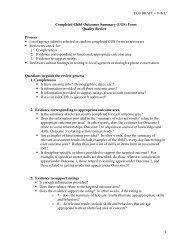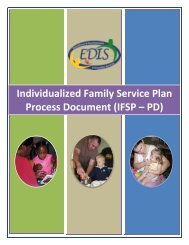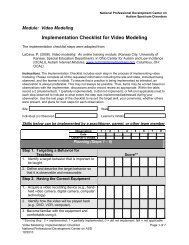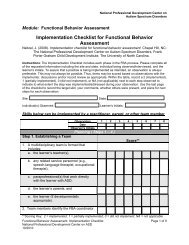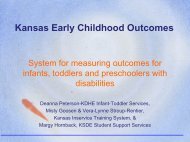Checklist for Naturalistic Intervention - National Professional ...
Checklist for Naturalistic Intervention - National Professional ...
Checklist for Naturalistic Intervention - National Professional ...
You also want an ePaper? Increase the reach of your titles
YUMPU automatically turns print PDFs into web optimized ePapers that Google loves.
<strong>National</strong> <strong>Professional</strong> Development Center onAutism Spectrum DisordersModule: <strong>Naturalistic</strong> <strong>Intervention</strong>Implementation <strong>Checklist</strong> <strong>for</strong> <strong>Naturalistic</strong> <strong>Intervention</strong>Franzone, E. (2009). Implementation checklist <strong>for</strong> naturalistic intervention. Madison, WI: The<strong>National</strong> <strong>Professional</strong> Development Center on Autism Spectrum Disorders, WaismanCenter, The University of Wisconsin.Instructions: The Implementation <strong>Checklist</strong> includes each step in the process of implementing naturalisticintervention. Please complete all of the requested in<strong>for</strong>mation including the site and state, individual beingobserved/interviewed, and the learner’s initials. To assure that a practice is being implemented asintended, an observation is always preferable. This may not always be possible. Thus, items may bescored based on observations with the implementer, discussions and/or record review as appropriate.Within the table, record a 2 (implemented), 1 (partially implemented), 0 (did not implement), or NA (notapplicable) next to each step observed to indicate to what extent the step was implemented/addressedduring your observation. Use the last page of the checklist to record the target skill, your comments,whether others were present, and plans <strong>for</strong> next steps <strong>for</strong> each observation.Site: ________________________________________ State: _________________________________Individual Observed: ________________________Learner’s Initials: ________________________Skills below can be implemented by a practitioner, parent, or other team memberPlanning ( Steps 1 -Step 1. Identifying a Target Behavior1. Select a specific target behavior to be thefocus of intervention that:a. focuses on prelinguistic or linguisticcommunication and/orb. social skills.2. Confirm that the target behaviors are in thelearner’s IEP or IFSP.Step 2. Collecting Baseline Data1. Prior to intervention, determine the learner’scurrent use of the target skill.2. Take data on the target skills a minimum ofthree times in more than one environment.Observation 1 2 3 4 5 6 7 8DateObserver’s InitialsScore****Scoring Key: 2 = implemented; 1 = partially implemented; 0 = did not implement; NA = not applicable<strong>Naturalistic</strong> <strong>Intervention</strong> Module Page 1 of 8<strong>National</strong> <strong>Professional</strong> Development Center on ASD10/15/2010
<strong>National</strong> <strong>Professional</strong> Development Center onAutism Spectrum DisordersModule: <strong>Naturalistic</strong> <strong>Intervention</strong>Observation 1 2 3 4 5 6 7 8DateObserver’s InitialsStep 3. Identifying the Contexts <strong>for</strong><strong>Intervention</strong>1. Determine the learner’s daily schedule.2. Identify the contexts in which naturalisticintervention will be embedded, including:a. learner-directed activities,b. routine activities, and/orc. planned activities.Step 4. Providing Training to TeamMembers1. Determine who will teach the skill.2. Provide adequate training to team membersbe<strong>for</strong>e initiating naturalistic intervention.Step 5. Arranging the Environment toElicit the Target Behavior1. Choose motivating materials/activities toengage learners and promote the use oftarget skills.2. Manage and distribute teaching materials in away that encourages learners tocommunicate.3. Arrange the intervention context andenvironment to:a. encourage the use of the targetact/skill andb. maintain learners’ interests.Step 6. Eliciting the Target ActStep 6A. Engaging the Learner in anInteraction1. Engage the learner in language-rich,learner-directed, and reciprocalinteractions that involve the followingtechniques:Score****Scoring Key: 2 = implemented; 1 = partially implemented; 0 = did not implement; NA = not applicable<strong>Naturalistic</strong> <strong>Intervention</strong> Module Page 2 of 8<strong>National</strong> <strong>Professional</strong> Development Center on ASD10/15/2010
<strong>National</strong> <strong>Professional</strong> Development Center onAutism Spectrum DisordersModule: <strong>Naturalistic</strong> <strong>Intervention</strong>Observation 1 2 3 4 5 6 7 8DateObserver’s Initialsa. following the learner’s lead,b. being at the learner’s level,c. responding to the learner’s verbal andnonverbal initiations,d. providing meaningful verbal feedback,ande. expanding the learner’s utterances.Step 6B. Using Strategies Based onApplied Behavior Analysis(ABA) to Elicit Target Behaviors1. Select a behavioral intervention (modeling,mand-modeling, modified time delay, orincidental teaching) to elicit the target act.(Please refer to steps below <strong>for</strong> these individualpractices.)Modeling2. Implement modeling by:a. establishing shared attention,b. presenting a verbal model,c. expanding the response and providingthe requested material (if the learnerresponds to the model correctly),d. providing another model (if the learnerdoes not respond or does not repeatthe model exactly),e. expanding the response and providingrequested material (if the learnerresponds to the model correctly),and/orf. providing the material and stating thecorrected response (if the learner does notrespond or does not repeat the modelexactly).**Scoring Key: 2 = implemented; 1 = partially implemented; 0 = did not implement; NA = not applicable<strong>Naturalistic</strong> <strong>Intervention</strong> Module Page 3 of 8<strong>National</strong> <strong>Professional</strong> Development Center on ASD10/15/2010
<strong>National</strong> <strong>Professional</strong> Development Center onAutism Spectrum DisordersModule: <strong>Naturalistic</strong> <strong>Intervention</strong>Observation 1 2 3 4 5 6 7 8DateObserver’s InitialsMand-Modeling3. Implement mand-modeling by:a. establishing shared attention,b. providing a verbal direction (mand) orquestion,c. expanding the response and providingthe requested material (if the learnerresponds correctly),d. providing another direction or a model(depending on learner’s needs <strong>for</strong>support) if the learner does notrespond or does not respond with thetarget,e. expanding the response and providingthe requested material (if the learnergives the target response), and/orf. providing the material and stating thetarget response (if the learner stilldoes not give the target response orrepeat the model exactly).Modified Time Delay4. Implement modified time delay by:a. establishing shared attention;b. waiting 3-5 seconds <strong>for</strong> the learner tomake request/comment;c. expanding on the request/commentand providing the requestedmaterial/activity (if the learnersinitiates at the target level);d. providing a mand or model,depending on the learner’s needs <strong>for</strong>support (if the learner does not initiateat the target level);e. expanding the request and providingthe material (if the learner respondscorrectly); and/orf. providing the material and stating thetarget response (if the learner stilldoes not give the target response orrepeat the model exactly).**Scoring Key: 2 = implemented; 1 = partially implemented; 0 = did not implement; NA = not applicable<strong>Naturalistic</strong> <strong>Intervention</strong> Module Page 4 of 8<strong>National</strong> <strong>Professional</strong> Development Center on ASD10/15/2010
<strong>National</strong> <strong>Professional</strong> Development Center onAutism Spectrum DisordersModule: <strong>Naturalistic</strong> <strong>Intervention</strong>Observation 1 2 3 4 5 6 7 8DateObserver’s InitialsIncidental Teaching5. Practitioners, parents, and other teammembers implement incidental teachingby:a. setting up the environment toencourage learner to requestassistance or materials,b. waiting <strong>for</strong> learner to initiate therequest,c. responding with a request <strong>for</strong>elaboration (if learner does not initiate withthe target response),d. continuing to prompt <strong>for</strong> theelaboration until learner respondsappropriately, and/or**Scoring Key: 2 = implemented; 1 = partially implemented; 0 = did not implement; NA = not applicable<strong>Naturalistic</strong> <strong>Intervention</strong> Module Page 5 of 8<strong>National</strong> <strong>Professional</strong> Development Center on ASD10/15/2010
<strong>National</strong> <strong>Professional</strong> Development Center onAutism Spectrum DisordersModule: <strong>Naturalistic</strong> <strong>Intervention</strong>Observation 1 2 3 4 5 6 7 8DateObserver’s InitialsIncidental Teaching (cont.)e. using model, mand-model, ormodified time delay procedures,depending on the needs of learner(if learner does not initiate arequest with the target act).Step 7: Using Data Collection toMonitor Learner Progress andDetermine Next Steps1. Practitioners, parents, and other teammembers collect data to evaluate thesuccess of the intervention and guidefuture decision making.Score****Scoring Key: 2 = implemented; 1 = partially implemented; 0 = did not implement; NA = not applicable<strong>Naturalistic</strong> <strong>Intervention</strong> Module Page 6 of 8<strong>National</strong> <strong>Professional</strong> Development Center on ASD10/15/2010
<strong>National</strong> <strong>Professional</strong> Development Center onAutism Spectrum DisordersModule: <strong>Naturalistic</strong> <strong>Intervention</strong>DateObserverInitialsTargeted Skill/Behavior, Comments, and Plans <strong>for</strong> NextStepsDateObserverInitialsTargeted Skill/Behavior, Comments, and Plans <strong>for</strong> NextStepsDateObserverInitialsTargeted Skill/Behavior, Comments, and Plans <strong>for</strong> NextStepsDateObserverInitialsTargeted Skill/Behavior, Comments, and Plans <strong>for</strong> NextStepsDate Observer Targeted Skill/Behavior, Comments, and Plans <strong>for</strong> Next<strong>Naturalistic</strong> <strong>Intervention</strong> Module Page 7 of 8<strong>National</strong> <strong>Professional</strong> Development Center on ASD10/15/2010
<strong>National</strong> <strong>Professional</strong> Development Center onAutism Spectrum DisordersModule: <strong>Naturalistic</strong> <strong>Intervention</strong>InitialsStepsDateObserverInitialsTargeted Skill/Behavior, Comments, and Plans <strong>for</strong> NextStepsDateObserverInitialsTargeted Skill/Behavior, Comments, and Plans <strong>for</strong> NextStepsDateObserverInitialsTargeted Skill/Behavior, Comments, and Plans <strong>for</strong> NextSteps<strong>Naturalistic</strong> <strong>Intervention</strong> Module Page 8 of 8<strong>National</strong> <strong>Professional</strong> Development Center on ASD10/15/2010


